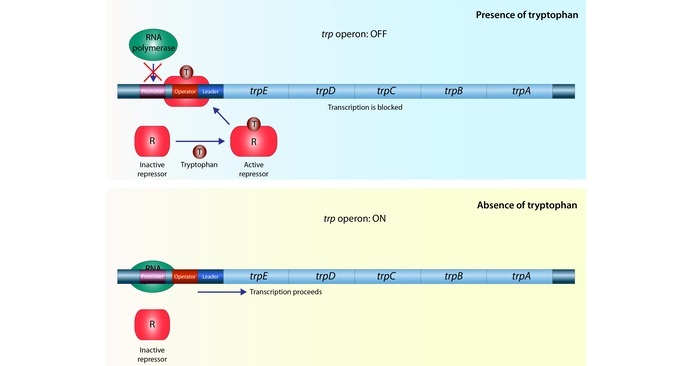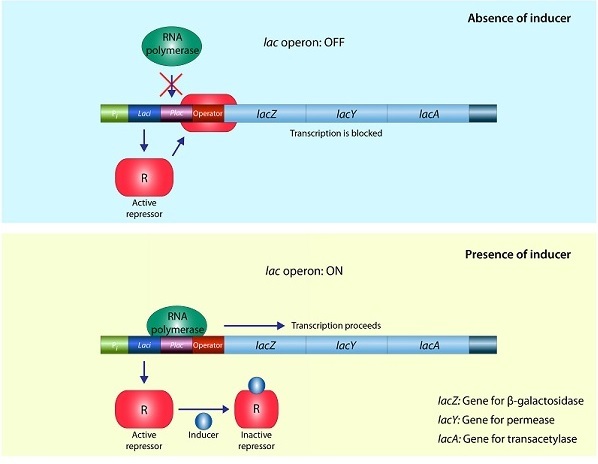
 Data Structure
Data Structure Networking
Networking RDBMS
RDBMS Operating System
Operating System Java
Java MS Excel
MS Excel iOS
iOS HTML
HTML CSS
CSS Android
Android Python
Python C Programming
C Programming C++
C++ C#
C# MongoDB
MongoDB MySQL
MySQL Javascript
Javascript PHP
PHP
- Selected Reading
- UPSC IAS Exams Notes
- Developer's Best Practices
- Questions and Answers
- Effective Resume Writing
- HR Interview Questions
- Computer Glossary
- Who is Who
What Is Difference Between Trp and Lac Operon
Introduction
Genes are the building blocks of life, and they determine everything from the color of our eyes to our susceptibility to diseases. Two of the most well-known and widely studied gene systems are the Trp and Lac operons.
These operons are involved in regulating the expression of genes in bacteria and play an essential role in the survival of these organisms. In this article, we will explore the differences between Trp and Lac operons, their significance, and how they function.

What is Trp and Lac operon?
Trp operon and Lac operon are two types of operons found in bacteria. An operon is a group of genes that are regulated together by a single promoter and operator.
The Trp operon is responsible for the biosynthesis of the amino acid tryptophan, while the Lac operon is responsible for the utilization of lactose as a carbon source.
The Trp operon is present in many bacteria, including Escherichia coli, and consists of five genes.
These genes are responsible for the biosynthesis of tryptophan, an essential amino acid required for protein synthesis.
The Trp operon is regulated by a repressor protein that binds to the operator region, which is located between the promoter and the first structural gene.
The Lac operon is also found in many bacteria, including E. coli, and consists of three genes. These genes are responsible for the utilization of lactose as a carbon source.
-
The Lac operon is regulated by a repressor protein that binds to the operator region, which is located between the promoter and the first structural gene.

Importance and Functionality
The Trp and Lac operons are found in bacterial genomes and are essential for the survival of these organisms. The Trp operon is important because it allows bacteria to produce tryptophan, an essential amino acid required for protein synthesis.
If tryptophan is not available in the environment, the Trp operon is activated, and the bacteria synthesize tryptophan.
The Lac operon is important because it allows bacteria to utilize lactose as a carbon source. Lactose is a complex sugar that is not readily available in the environment. Therefore, when lactose is present, the Lac operon is activated, and the bacteria utilize lactose as a source of carbon.
The functionality of these operons is regulated by the presence of specific molecules in the environment. For the Trp operon, the presence of tryptophan in the environment represses the operon. When tryptophan levels are low, the Trp operon is activated, and the bacteria synthesize tryptophan.
For the Lac operon, the presence of glucose in the environment represses the operon. When glucose levels are low, and lactose is present, the Lac operon is activated, and the bacteria utilize lactose as a source of carbon.
What is the difference between Trp and Lac operon?
The Trp operon and Lac operon differ in their functions, regulation, and genetic organization.
The Trp operon is responsible for the biosynthesis of an amino acid, while the Lac operon is responsible for the utilization of a complex sugar.
The Trp operon is regulated by a repressor protein that binds to the operator region in the absence of tryptophan, while the Lac operon is regulated by a repressor protein that binds to the operator region in the presence of glucose.
The Trp operon consists of five genes, while the Lac operon consists of three genes.
The differences between the Trp and Lac operons can be identified by studying their genetic organization, regulation and function.
The Trp operon consists of five genes, trpE, trpD, trpC, trpB, and trpA, that are responsible for the biosynthesis of tryptophan.
The first three genes are responsible for the conversion of chorismate to anthranilate, while the last two genes are responsible for the conversion of anthranilate to tryptophan.
On the other hand, the Lac operon consists of three genes, lacZ, lacY, and lacA.
The first gene, lacZ, encodes ?-galactosidase, an enzyme that breaks down lactose into glucose and galactose.
The second gene, lacY, encodes lactose permease, a protein that transports lactose into the cell.
The third gene, lacA, encodes transacetylase, an enzyme that has a minor role in lactose metabolism.
Another significant difference between the Trp and Lac operons is the way they are regulated.
The Trp operon is negatively regulated, which means that the presence of tryptophan in the environment turns off the operon.
The repressor protein, when bound to tryptophan, binds to the operator region, preventing the RNA polymerase from transcribing the genes.
In contrast, the Lac operon is positively regulated, which means that the presence of lactose in the environment turns on the operon.
The repressor protein, when not bound to lactose, binds to the operator region, preventing the RNA polymerase from transcribing the genes.
However, when lactose is present, it binds to the repressor protein, changing its conformation, and preventing it from binding to the operator region, allowing the RNA polymerase to transcribe the genes.
Interesting Facts About Trp and Lac Operon
A few of the facts are listed below ?
The Trp and Lac operons were discovered in the 1950s by François Jacob and Jacques Monod, who were awarded the Nobel Prize in Physiology or Medicine in 1965 for their work on the genetic control of enzyme synthesis.
The Lac operon is sometimes called the lactose operon, while the Trp operon is sometimes called the tryptophan operon.
The regulation of the Trp operon is known as negative feedback inhibition, while the regulation of the Lac operon is known as positive feedback activation.
The Lac operon has been extensively studied and is one of the most well-understood gene regulatory systems in biology.
The Trp operon is also present in some archaea and eukaryotes.
FAQs
Q1. Why are the Trp and Lac operons important?
Ans. The Trp and Lac operons are important because they allow bacteria to synthesize essential amino acids and utilize complex sugars as a source of carbon, respectively.
Q2. What is the difference between positive and negative regulation?
Ans. Positive regulation is when a molecule or protein activates the expression of genes, while negative regulation is when a molecule or protein represses the expression of genes.
Q3. Can the Trp and Lac operons be found in eukaryotes?
Ans. The Trp operon can be found in some archaea and eukaryotes, while the Lac operon is specific to bacteria.

